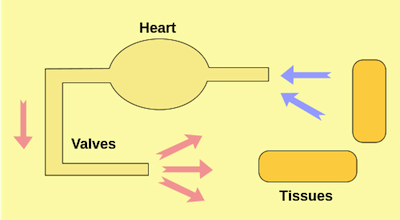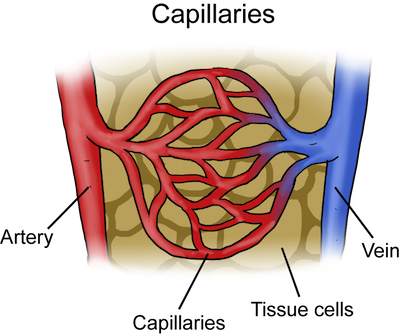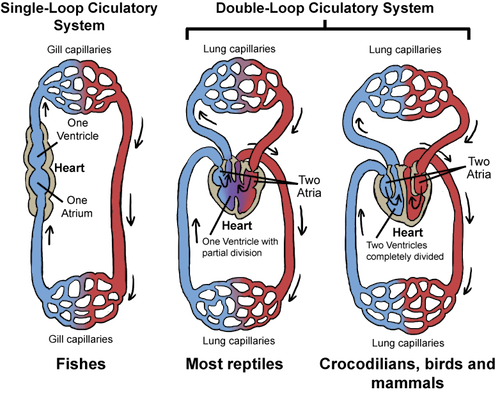Animal Circulation
Basics of Circulatory Systems: Open vs. Closed
Animals are made of trillions of cells, and each cell in the body needs a supply of oxygen and nutrients in order to survive. To deliver these things and take away wastes, nearly all animals need a special delivery system, which is called the circulatory system. There are two types of circulatory systems: open and closed.The open circulatory system is found in arthropods and mollusks. Open means there are no vessels, so all the body goo is just floating around free in the animal’s body cavity, which is called a hemocoel.
Even though there’s no vessels, these guys still have a heart. The heart pumps a blood-like substance directly into the hemocoel, and it sloshes around splashing over the organs. The organs get all the nutrients they need from this blood bath. In the hemocoel, blood and interstitial fluid (a special fluid that surrounds cells) is combined into a substance called hemolymph. This is the goo that squishes out of bugs when they get stepped on.

A diagram of an open circulatory system. The heart pumps hemolymph out into the body cavity (pink arrows) where it can directly bathe the tissues and provide nutrients and oxygen to them without the use of blood vessels. Image from here.
In arthropods, the heart consists of a tube-like structure which runs along an insect's back and contracts to move hemolymph from the butt to head. In the abdominal section, there are a series of valves, called ostia, which allow hemolymph to enter the heart and get pumped into the anterior of the hemocoel.
In mollusks, the hemolymph uses hemocyanin (instead of hemoglobin, which we’ll read about in a minute) to carry oxygen. Oxygenated hemocyanin is blue. Hemocyanin is not part of any cell, but rather is suspended on its own within the hemolymph. Insect hemolymph doesn’t need to carry oxygen, since insects have a separate system for gas exchange.
Animals with an open system can’t send their body fluids to a particular region of the body. It just flows around and the animal hopes for the best. When the animal moves, it gets shifted around, but precise delivery is difficult.
While the open system works fine for smaller animals, it just won’t cut it for the big guys. It would require a tremendous amount of work to pump blood through a single large open body cavity and to make sure all areas of the body received their share. It’s like when your arm falls asleep and you have to flap it around like mad to get the blood flowing again. Imagine doing all the time because all your parts keep losing blood flow. Yikes.
Circulatory System Components
Instead of having an open system, many large animals use a closed circulatory system. This means that the blood is enclosed in a highway of vessels rather than flowing freely inside the body cavity.By retaining the blood inside tiny blood vessels, blood can be pumped to the far reaches of larger animals. It also gives the animal the ability to pump more blood to some areas and not others. While great for keeping blood pumping to your extremities, a closed system means that blood isn’t in direct contact with the plasma membrane of the cells. Diffusion of nutrients has to take place in two steps, first out of the blood vessel and then into the cell.

A diagram of a closed circulatory system. The blood is enclosed in a series of blood vessels and it is pumped through them to different parts of the body. Image from here.
Heart
The heart is the key to any circulatory system, because it provides the muscle power to move the blood throughout the entire body, even to itself. The arteries that supply blood to the heart are called coronary arteries, and they are the bright red blood vessels shown crisscrossing the top of the heart in the picture.
A human heart. Notice the red blood vessels running across the top. These are the coronary arteries, which supply blood to the powerful heart muscle. Image from here.
Hearts come in many sizes; typically, the size of the heart is directly proportional to the size of the animal. The heart of a tiny fairy wasp is less than 0.2mm. The heaviest heart ever recorded belonged to a great blue whale and weighed 1980 pounds. That's a ton of heart.
In a closed system, many animals have hearts with distinct chambers. Fish have a two-chambered heart. The two cavities are called the atrium and the ventricle (sound familiar?). Blood always enters the heart in an atrium (“atrium” is a Latin word meaning the main entry of a building or house. So the atrium of your heart is like the main entrance hall) and always leaves the heart through a ventricle. For this reason, ventricles are always stronger than atriums, because they provide the forceful push that sends the blood on its long journey throughout the body.
Amphibians and reptiles have a three-chambered heart that has two atria and one ventricle. Birds and mammals have a four-chambered heart, which add a second ventricle to the mix. There are heart valves between the heart chambers—they are flaps of tissue that prevent backward blood flow. We’ll discuss the pattern of blood flow through the heart later.
The heart is muscle, and the powerful heart contractions are stimulated by an electrical signal created by a group of cells in an area of the heart called the sinoatrial node, which tells the heart to beat. In humans, the heart beats every 1.0–1.6 seconds.
Blood Vessels
All good things come in threes. The Three Musketeers, a three-ringed circus, three-legged races. Threes are cool. Blood vessels also come in three varieties: arteries, veins, and capillaries.Arteries carry blood away from the heart. They’re made of three layers of tissue, and the inside layer is coated with special anti-clotting factors that keep the blood from clogging. Unlike a clogged toilet, a clogged blood vessel can kill you, so it's important to keep blood flowing smoothly. (Smooth flow is also important for toilets.) The middle layer contains muscle and elastic fibers, and the outside is a bunch of connective tissue and elastic fibers. Blood shoots through with a lot of force, so having elastic arteries is a must.

Interface where arteries split into capillaries, gases are exchanged with the nearby cells, and then the capillaries join together to form veins that take the deoxygenated blood back to the heart.
Capillaries are the tiniest blood vessel, about 1 mm in length and made of epithelial cells. These tiny guys are only one cell thick and are so narrow that red blood cells have to go through single file. This allows for easier diffusion of gasses and nutrients.
Veins carry blood returning to the heart, and since the blood they are carrying is under less pressure, they are built differently than arteries. They have thinner walls and are wider, which encourage the blood to flow back to the heart. Veins have one-way valves incorporated into them, which prevent blood from flowing backwards away from the heart.
Blood
In vertebrates, blood consists of cells, cell fragments, and plasma. Plasma contains various nutrients, dissolved gasses, and special immune system proteins, and the white blood cells, platelets, and red blood cells float around inside.
Three types of blood cells: red (left), platelet (middle), and white (right). Image from here.
White blood cells are the body's militia. They patrol the body to defend it from pathogens, like viruses and bacteria. Platelets are cell fragments that are key ingredients in forming a blood clot. If you cut yourself and start to bleed, the platelets will form a net-like web at the site of the injury and prevent blood loss. Together with other proteins found in the plasma, they will plug the injured site until it can be properly repaired.
Red blood cells are round disc-shaped cells whose primary function is carrying oxygen to the cells and carrying carbon dioxide away from them. They’re a laundry service that delivers. Clean in, dirty out. Red blood cells are filled with hemoglobin, which is the key protein for gas exchange. Hemoglobin is high in iron, which gives blood its red color. When a red blood cell is carrying oxygen, it’s bright red in color. When it is deoxygenated, it takes on more of a purple color, which is why the veins in your wrist look blue.
Pathway of Blood Flow
In a closed circulatory system, the blood travels in either a single or double circulation pathway. The two pathways differ in how many times the heart pumps the blood during a single cycle of circulation.Fish have a single circulatory system, in which the blood is first pumped from the heart to the gills. This is the Shell gas station of the fish; it's where the blood loads up on oxygen. Blood flowing through the gills is slow because of the tiny narrow capillaries and the massive gas exchange taking place. This loss of momentum is the downside to a single circulation system. When the blood exits the gills it just barely has enough pressure to make it around the rest of the body. For every cycle though the body, it goes to the heart one time.

Diagram of the differences in animal circulatory systems.
In larger animals, a single pump of the heart isn’t enough to send the blood to the lungs, around the body, and back again. Instead, mammals, birds, reptiles, and amphibians have a double circulation pathway. This means that the heart pumps twice to circulate the blood throughout the body.
The first pump is for pulmonary circulation, which sends the blood to the lungs to get its fill of oxygen. Then the blood returns it to the heart. The heart takes a big gulp of air, and then sends the rest out for systemic circulation. The heart pumps again and oxygenated blood makes its way to the rest of the body. This teamwork provides enough pressure for the blood to get through the lungs and make it through the rest of the body.
The movement through the heart in the double circulation system always goes right side, then left. So we start in the right atrium and then head to the right ventricle. From the right side, the next stop is the lungs. Then it’s back to the heart where it enters the left atrium. Finally to the left ventricle for one final push out to the far corners of the body.
Need a catchy tune to remember how blood flows through the body? Don’t worry…you're covered.

If there’s only one ventricle, as in amphibians and reptiles, the same pathway is followed, except that the right and left ventricles are a single cavity.
Uses of the Circulatory System
The circulatory system is our home-delivery service, bringing oxygen and nutrients to all our cells. When we exercise our muscles, we’re using oxygen very quickly and as a result, our cells need us to speed up the delivery cycle. This is why our breathing and heart rate both increase when we exercise.The circulatory system is also important for removing wastes from the cells. In many animals, the waste is delivered to the kidneys and the liver where it’s processed for excretion from the animal. The circulatory system is also involved in temperature regulation.